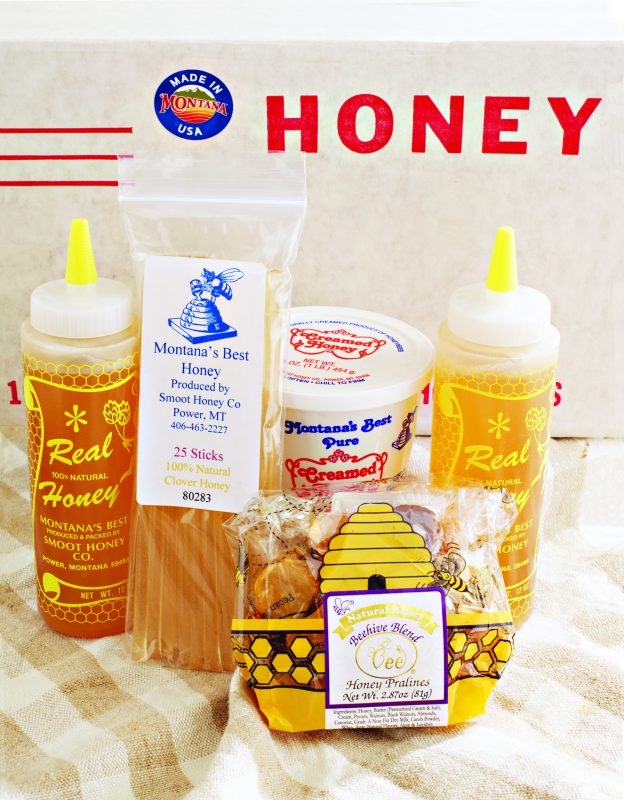A Sweet Industry for North Central Montana
Text by Suzanne Waring and Photography by Penny Smoot
A honeybee flits from one flower to another in your garden. Instead of waving the bee away, step back and allow it to do its work because bees are important to our livelihoods. According to the American Honey Producers Association, bees pollinate one-third of the food we eat. Without bees we wouldn’t have that food. For us here in North Central Montana, the good news is that the honeybees at Smoot Honey Company, Inc., are here. They arrived back in Montana from their winter home the first two weeks of April.
The work that Smoot Honey owners do in the summer is to provide their honeybees with the optimum environment to make honey. They put the bees that arrive in special shipping boxes into white hive boxes containing frames to be filled with honey by the bees. The owners take these boxes out to CRP land, hayfields of clover and alfalfa, or fields of canola in the Cascade, Conrad, and Fairfield Bench areas where the bees will do their work of finding nectar in flowers and transforming it into honey.
Throughout the summer, Smoot employees remove the honey-filled frames and insert empty frames into the hives so the bees have a place to continue to store honey. When asked about getting stung, “At the beginning of the season, we notice when we get stung. After that we don’t even notice it, but usually the bees don’t sting us,” said Mark Jensen, one of the owners.
Commercial beekeeping operations are frequently family businesses that are handed down from generation to generation, and the Smoot people are no different. They have been doing this work from the company’s headquarters in Power, Montana, since 1964. Previous to that, Boyd Smoot had a honey production business in Yorba Linda, California. He and his son, Don, were dissatisfied with the congestion, urban sprawl, and pesticides being used in the almond and orange groves in California, so they looked around and found that Irving W. Ohmstede in Power, Montana, was ready to sell his small business that had had its headquarters in Power since around 1935.
The company is still in the Smoot family. With the retirement of Boyd and death of Boyd’s other son, Dennis, who had joined the company in 1966, Don ran the operation for many years. In 1996 Don decided to look at retirement so Dan Smoot (son), Mark Jensen (son-in-law) and James Rehm (nephew) came to work full time. In 2007 the three agreed to purchase Smoot Honey Company from Don. To efficiently run the business, they have one full-time and one part-time additional employees. Since taking over ownership, they have been determined to make this 52-year old company grow.
Even with a major fire in 2013 in one of their key buildings, they have moved their company forward. The number of hives has increased from 2,800 in the 1960’s to 5,400. The company now processes around 600,000 pounds of honey annually.
Over the years, the business has become increasingly mechanized. Trucks and forklifts for moving bees and pulling honey and state-of-the-art extracting equipment speed the processing and packaging. During the summer months the honey is put into as many as eight hundred 55-gallon barrels. They pack the honey from the barrels into usable containers all year long. About half of the honey is sold retail and is packaged in consumer-sized containers and tubs. Bakeries, breweries, foodservice companies, and food manufacturers purchase honey in many different sized bulk containers—one size being a 300-gallon tote. For example, they transport these totes of honey to Dailey’s Premium Meats in Missoula where bacon is cured in honey. In general, honey is used as a sweetener, energy food, ingredient in skincare products, and as a cough suppressant.
Smoot also produces blocks of wax left over from the honey extraction process and sells them to companies that make beekeeping supplies, candles, and lip balm, along with other items manufactured with wax. They sell between 135,000-180,000 lbs. of wax each year.
Smoot has had permission from many of the same farming families to place hives in the same locations since Smoot started the honey business in Montana. There’s a convenience to having bee hives on a property. The bees pollinate the flowering crops while making honey for the Smoots who keep these farm families supplied with that natural sweetener.
A site for five or more hives is called an apiary. The company places around 32 hives at each apiary, and approximately 150 sites are maintained. During the summer, employees put thousands of miles on vehicles traveling from one site to another. On the average 108 pounds of honey is taken from each hive during the summer. Interestingly, bees visit as many as 2 million flowers to make one pound of honey.
Many companies advertise that their honey is orange blossom or clover honey, but it is difficult to know that honey is one-hundred percent of one type. One simply can’t determine where the bees have gone to find nectar in flowering plants. Some of them may have ended up taking nectar from the various flowers in your field or garden.
The five states for biggest honey production are North Dakota, Montana, South Dakota, Florida, and California. “In 2015, Montana came in third according to the United States Department of Agriculture (USDA),” said Jensen. “We are in the top five every year, and North Dakota usually gets the first-place honor.”
There are 86 beekeepers in Montana that have sought commercial classification; however, only seven suppliers, including Smoot Honey, are large enough to want to be a part of the National Honey Board that does research and provides education about honey. These Montana companies processed and sold 12.1 million pounds of honey in 2015, according to the USDA National Agriculture Statistics Service. This puts the honey industry in tenth place as a valuable crop for Montana.
Honey is honey, and there shouldn’t be any other ingredients in a container of honey. The honey producers in the United States find competition with foreign countries that sell a syrup product as honey. Presently as much as two-thirds to three-fourths of the honey sold in the United States is an import. “Although the United States has an anti-dumping order on honey imported from China, its adulterated or circumvented “funny honey” still gets into the retail chain by going through the backdoor of another country that has no duty on their honey,” said Jensen.
The best way that a consumer can make the distinction is to determine from the label whether the honey is produced at a specific location in the United States. When the consumer recognizes the packaging location, the greater is the possibility that the product is real honey. Honey can be whipped or creamed, but still the only ingredient is honey. Some honey products also have a part of the comb included.
Honey is one of nature’s natural products. Eat it on your toast; include it in your recipes. Smoot Honey can be purchased from the Everyday IGA on the north side, 2J’s, and Great Harvest Bread, among other retail outlets in the Great Falls area.

